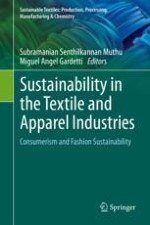2020 | OriginalPaper | Buchkapitel
Does Advertising Appeal Type Make a Difference? A New Sustainable Fashion Product by a Luxury and Mainstream Brand
verfasst von : Feray Adıgüzel
Erschienen in: Sustainability in the Textile and Apparel Industries
Aktivieren Sie unsere intelligente Suche, um passende Fachinhalte oder Patente zu finden.
Wählen Sie Textabschnitte aus um mit Künstlicher Intelligenz passenden Patente zu finden. powered by
Markieren Sie Textabschnitte, um KI-gestützt weitere passende Inhalte zu finden. powered by
